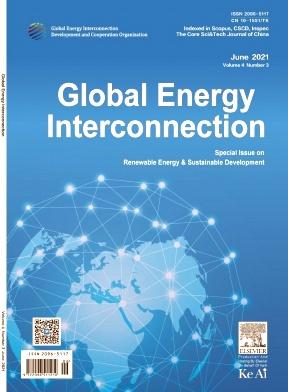Power-to-hydrogen-and-methanol model based on collaborative optimization of energy flow and material flow
IF 2.6
Q4 ENERGY & FUELS
引用次数: 0
Abstract
China has abundant renewable energy resources. With the establishment of carbon peaking and carbon neutrality goals, renewable energy sources such as wind power and photovoltaics have undergone tremendous development. However, because of the randomness and volatility of wind and photovoltaic power, the large-scale development of renewable energy faces challenges with accommodation and transmission. At present, the bundling of wind–photovoltaic–thermal power with ultra-high voltage transmission projects is the main development approach for renewable energy bases in western and northern China. Nonetheless, solving the problems of high carbon dioxide emission, carbon dioxide capture, and the utilization of thermal power is still necessary. Based on power-to-hydrogen, power-to-methanol, and oxygen-enriched combustion power generation technologies, this article proposes a power-to-hydrogen-and-methanol model based on the collaborative optimization of energy flow and material flow, which is expected to simultaneously solve the problems of renewable energy accommodation and low-carbon transformation of thermal power. Models with different ways of linking power to hydrogen and methanol are established, and an 8760-hour-time-series operation simulation is incorporated into the planning model. A case study is then conducted on renewable energy bases in the deserts of western and northern China. The results show that the power-to-hydrogen-and-methanol model based on the collaborative optimization of energy flow and material flow can greatly reduce the demand for hydrogen storage and energy storage, reduce the cost of carbon capture, make full use of by-product oxygen and captured carbon dioxide, and produce high-value chemical raw materials, thus exhibiting significant economic advantages.
基于能量流和物料流协同优化的动力制氢制甲醇模型
中国拥有丰富的可再生能源资源。随着碳调峰和碳中和目标的确立,风电、光伏等可再生能源得到了巨大的发展。然而,由于风能和光伏发电的随机性和波动性,可再生能源的大规模发展面临着调节和传输方面的挑战。目前,中国西部和北方地区可再生能源基地的主要发展方式是风力-光热发电与特高压输电项目捆绑发电。尽管如此,解决二氧化碳的高排放、二氧化碳的捕获和热电的利用问题仍然是必要的。本文以电制氢、电制甲醇、富氧燃烧发电技术为基础,提出了一种基于能量流和物质流协同优化的电制氢-甲醇模型,有望同时解决可再生能源容纳和火电低碳改造问题。建立了电力与氢、甲醇连接方式不同的模型,并将8760小时的时序运行仿真纳入规划模型。然后对中国西部和北部沙漠的可再生能源基地进行了案例研究。结果表明,基于能流和物流协同优化的电制氢-甲醇模型可以大大降低储氢和储能需求,降低碳捕集成本,充分利用副产氧和捕集二氧化碳,生产高价值化工原料,具有显著的经济优势。
本文章由计算机程序翻译,如有差异,请以英文原文为准。
求助全文
约1分钟内获得全文
求助全文
来源期刊

Global Energy Interconnection
Engineering-Automotive Engineering
CiteScore
5.70
自引率
0.00%
发文量
985
审稿时长
15 weeks
 求助内容:
求助内容: 应助结果提醒方式:
应助结果提醒方式:


